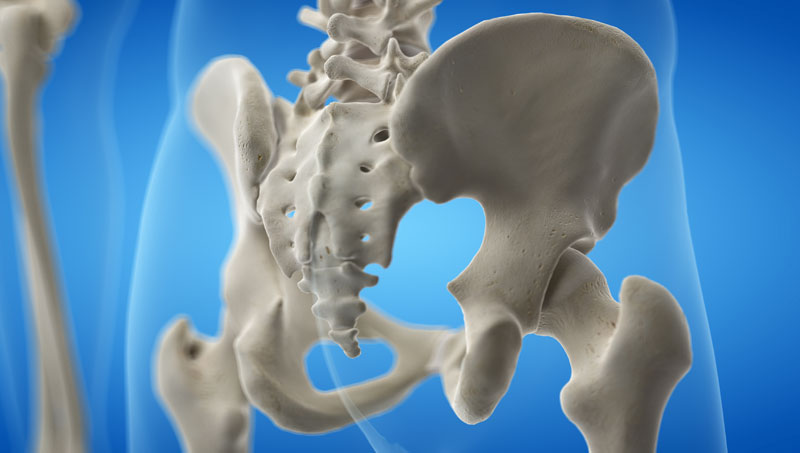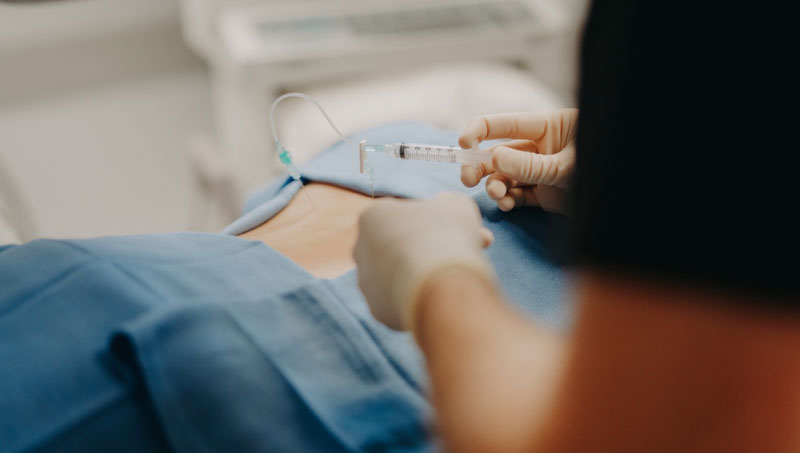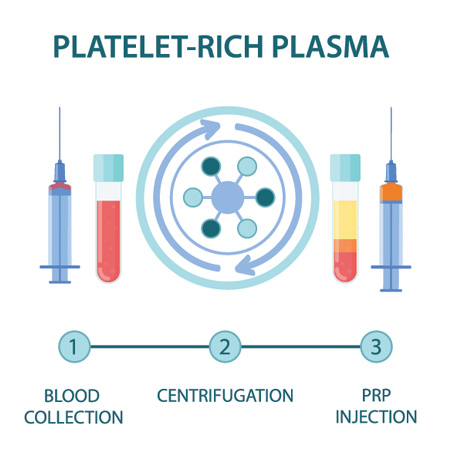Sacroiliac Joint Pain
What is sacroiliac joint pain?
The sacroiliac (SI) joint is formed between the sacrum, the spinal segment inferior to the lumbar spine, and the ilium (back of the pelvis). This joint moves very little, typically only a few millimeters; however, its primary role is that of force transmission or offloading. Forces that may be transmitted from the lower limb up the spine, the spine to the lower limb, or around the pelvis may be managed by the SI joint. When the capacity of the joint to bear load or force is exceeded, this may manifest as pain and discomfort.

What causes sacroiliac joint pain?
The most common causes of SI joint pain may include excessive biomechanical stress, trauma, pregnancy, and sports injuries. Less commonly, spondyloarthropathies (e.g. ankylosing spondylitis), infection, or tumors/malignancy may be a source of SI joint pain. It should also be noted that patients who have previously undergone lumbar fusion surgery are at an increased risk of developing SI joint pain.
How is sacroiliac joint pain diagnosed?
The diagnosis of SI joint pain is primarily a clinical diagnosis. In other words, it is based on the patient’s symptoms and physical examination findings. Typically, a patient with SI joint pain will present with low back/buttock pain which can occasionally be referred to the thigh, hip, groin, or calf. On physical examination, these patients will experience reproduction of their pain with multiple provocative maneuvers. In the end, the gold standard method of diagnosis for SI joint pain is patient response to diagnostic injection such as an intra-articular SI joint injection or sacral lateral branch blocks.
How is sacroiliac joint pain treated?
Initial treatment options for management of SI joint pain may include medications, physical therapy, and/or chiropractic. In many cases, these conservative measures will allow for good recovery. If a patient is still experiencing significant pain despite the aforementioned treatment options, a SI joint injection with a combination of local anesthetic (numbing medication) and corticosteroid (cortisone or anti-inflammatory medication) can be considered as the next step in the treatment pathway. Alternative interventional options may include radiofrequency ablation (RFA) of sacral lateral branch nerves or SI joint platelet-rich plasma (PRP) injections.
Sacroiliac Joint Injection
Using x-ray (fluoroscopic) guidance, a needle is guided into the SI joint. Once the needle is in the joint, a solution of corticosteroid, an anti-inflammatory medication, and local anesthetic, a “numbing” medication, is instilled through the needle and into the joint with the goal of decreasing the pain and improving function. If the patient experiences a significant improvement in pain during the time the local anesthetic is blocking the painful joint, it can be determined with increased certainty that the SI joint is the primary source of pain. Then, the corticosteroid helps to decrease inflammation and provide longer lasting improvement in pain.

Sacral Lateral Branch Blocks and Radiofrequency Ablation
When a person’s SI joint is emanating pain, the sacral lateral branch nerves will sense this pain signal and transmit it along a pathway to the spinal cord and up to the brain where we interpret and “feel” that painful sensation. As such, lateral branch nerve blocks can be used as a diagnostic injection to help determine whether or not the SI joint is the primary source of pain. Using x-ray (fluoroscopic) guidance, needles are safely guided to and placed near the lateral branch nerves which are then anesthetized, thus temporarily blocking the pain coming from the SI joint. Patients are then asked to monitor their pain during the time period that the local anesthetic is blocking the SI joint pain. In patients who experience a significant improvement in their pain, it increases the likelihood that the SI joint is the main source of pain and radiofrequency ablation (RFA) can then be performed as a treatment to provide long lasting improvement in the pain. In patients who do not experience much improvement in their pain during the anesthetic phase, it can be determined with much more certainty that the SI joint is not the main source of the pain and the focus can shift to other potential pain generating structures.
After a patient has undergone sacral lateral branch nerve blocks to more precisely determine that the SI joint is the primary source of pain, radiofrequency ablation (RFA) can then be performed. With RFA, the needle tip is placed in close proximity to the lateral branch nerve (the nerves that supply sensation to the painful SI joint). The needle tips are then warmed up to a temperature that causes coagulation or “cauterization” of the lateral branch nerve. This disrupts the nerves that sense the pain coming from the SI joint and, consequently, disrupts the pathway for that pain to be sensed and transmitted to the brain. In the end, RFA can provide long lasting improvement in SI joint pain, typically 6-12 months at a time, and repeat RFA procedures can be performed time and again to allow for ongoing pain relief for patients.
Platelet Rich Plasma (PRP) injection
PRP is component of the patient’s own blood. It is rich in growth factors and other cells that signal an increased healing response to a damaged tissue. It is used to treat a variety of painful spine and musculoskeletal conditions.
Blood is drawn from a patient and then placed in a centrifuge for it to be “spun down.” This causes the different components of the blood to separate out in the vial. The PRP solution is then drawn up into a syringe and prepared to be injected at the site of the patient’s injury.

Discontinue use of all non-steroidal anti-inflammatory drugs (NSAIDs) at least 7 days prior to the procedure. These may include ibuprofen (Advil, Motrin), naproxen (Aleve), meloxicam (Mobic), diclofenac (Voltaren), indomethacin (Indocin), and celecoxib (Celebrex). If you are taking oral corticosteroids such as prednisone or a Medrol Dosepak, please discuss this with Dr. Best prior to your procedure. In some cases, Dr. Best may request that the corticosteroid medication be discontinued in preparation for the PRP injection. Do NOT stop aspirin unless specifically instructed by Dr. Best. Depending on which body part is injected, you may need a driver or alternative form of transportation to and from your procedure. If you have any questions or concerns about whether to continue or discontinue any of your medications leading up to your PRP injection, please discuss these issues with Dr. Best and his team.
Once the PRP solution is created, the patient is positioned for the procedure. The skin is thoroughly cleaned and the target for the injection obtained with ultrasound or fluoroscopy (x-ray). Then, a numbing solution is injected at the skin and subcutaneous tissues for increased procedural comfort. Finally, under ultrasound or fluoroscopic (x-ray) guidance, the needle is guided to the injury site and the PRP solution is deposited.
It is common to experience mild to moderate pain or discomfort during the initial 0-3 days after the PRP procedure. Post-procedure pain can be easily managed with acetaminophen (Tylenol) or other non-NSAID pain medication. Try to avoid applying ice or heat to the injection site.
During the 3–14-day period after the PRP injection, you may gradually increase physical activity. Please continue to avoid use of NSAIDs; however, ice may be applied for short periods of time throughout the day to aid in management of post-procedure soreness/discomfort if present.
During the 2–4-week period after the PRP, Dr. Best may recommend initiation of a course of physical therapy to aid in recovery and optimization of healing. The patient may begin to note improvement in pain during this time period, though it often takes one month or more for the benefits of PRP to take hold.
At this time, PRP injections are not typically covered by any insurance companies. Pricing and payment options can be discussed with Dr. Best and his team prior to your procedure.
As an alternative to PRP injections, sacroiliac joint injections with corticosteroid can be performed to help alleviate SI joint pain. Using x-ray (fluoroscopic) guidance, a needle is guided into the SI joint. Once the needle is in the joint, a solution of corticosteroid, an anti-inflammatory medication, and local anesthetic, a “numbing” medication, is instilled through the needle and into the joint with the goal of decreasing the pain and improving function. If the patient experiences a significant improvement in pain during the time the local anesthetic is blocking the painful joint, it can be determined with increased certainty that the SI joint is the primary source of pain. Then, the corticosteroid helps to decrease inflammation and provide longer lasting improvement in pain.
At a Glance
Dr. Craig Best
- Harvard Fellowship-Trained Interventional Spine & Sports Medicine Specialist
- Double Board-Certified in Physical Medicnie & Rehabilitation and Pain Medicine
- Assistant Professor of Physical Medicine & Rehabilitation and Orthopedic Surgery
- Learn more

